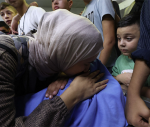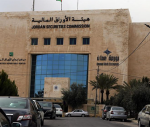You are here
Jordan’s northeast hidden treasures of ancient cities, villages reveal a Byzantine past
By Saeb Rawashdeh - Nov 03,2023 - Last updated at Nov 03,2023

A courtyard at Umm Es Surab, a site located near Mafraq with the history of occupation that goes back to the Roman and Byzantine periods (Photo courtesy of P. Gilento)
AMMAN — The northeast of Jordan is home of number of ancient cities and villages from the Late Roman and Byzantine period, which served as a frontier to Sassanid Empire.
“Those sites have astonishingly survived until today, but the most significant is Umm Al Jimal near Mafraq,” said a Swiss archaeologist and architect Ulrich Bellwald, noting that “all these sites are stringed like the pearls in a necklace alonga local road, winding through the gently ascending hills between the border of Jordan to Syria and the highway leading from Mafraq eastwards to the Iraqi and Saudi border”.
Over a distance of only 65 km from Mafraq to the East there are 10 major sites from Late Roman and Byzantine period to be visited in the area, and all these sites are almost completely unknown for tourists.
Most of them are very well preserved, showing complete houses with conserved ceilings and rooms with remnantsof the interior equipment, such as shelves inserted into the walls, food containers madefrom clay in order to protect the content from mice and beautifully dressed animal feeders, Bellwald continued, adding that most of the well preserved architecture is purely domestic, but there are alsochurches showing up as inherent parts of the residential areas.
The actual town of Sama Es Sirhan is located about 17km to the north of Mafraq. Theancient Late Roman and Byzantine village is situated exactly in the centre of the modern town, divided by its main road into a smaller eastern and a more extended western part.
“The eastern part of the site is dominated by the remains of the church dedicated to St George, where as the western part is packed with large Byzantine homesteads with a great variety of stables and residential houses, many of them still showing the original roofs,” Bellwald said.
The actual town of Umm Es Surab is located about 22km to the northeast of Mafraq.
“The eastern part of the site shows impressive building compounds of monasteries and churches along its western limitation and a densely overbuilt residential quarter withhouses, stables and corrals for animals on its eastern surface. The western quarter is characterised by large Byzantine homesteads, again with a great variety of stables andresidential houses and spacious corrals for animals,” Bellwald underlined, adding that many of the houses still have theiroriginal roofs and staircases, especially well visible in the interior of the monastery tower.
Moreover, the church of the monastery was dedicated to Sergius and Bacchus and built in 489AD, he underlined, noting that after the Islamic conquest of the area it was converted into a mosque and a minaret was added to the structure.
“The mosque was used through Ayyubid period until Mamluk period,” Bellwald stressed.
The modern village of Subheya is located about 18km to the northeast of Umm Al Jimal when the ruins of the Late Roman-Byzantine settlement may be found at thesouthern edge of the modern village, stretched along a secondary street parallel to the main road leading from Umm El Jimal towards the East, the scholar said.
“The ancient settlement consists ofaround 10 extended farmsteads with the buildings arranged around courtyards. It has tobe highlighted, that all the houses in Subheya are outstandingly well preserved, all ofthem with the ancient roof constructions still in situ. For the moment there is one main cistern visible in the eastern part of the ancient village,” Bellwald underlined.
Thinking about the necessary strategy for the promotion of Jordanian archaeological sites in the northeast of the country, Bellwald maintains that stimulation and development are vital for economic sector that will provide new job opportunities for the local community
“For assuring the success of any initiative in promotingtourism to the region by reactivating its rich cultural heritage, it is indispensable toinvolve the local communities, because at the end it will be them to prepare, maintainand operate the touristic use of the sites,” Bellwald concluded.
Related Articles
AMMAN — The northeastern part of Jordan is one of the most overlooked regions in terms of touristic offers across the country, despite the e
AMMAN — Remains of ancient houses and funerary inscriptions from the Roman period have been found in Dafyana, a site located in southern Haw
IRBID — Umm Al Jimal in southern Jordan had a “strong ecclesiastical character” as testified by its 16 well preserved Byzantine churches, ac
Opinion
Nov 03, 2023
Nov 03, 2023
Nov 01, 2023
- Popular
- Rated
- Commented
Nov 03, 2023
Nov 03, 2023
Oct 31, 2023
Nov 03, 2023
Newsletter
Get top stories and blog posts emailed to you each day.
















